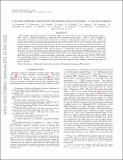A 2km-size asteroid challenging the rubble-pile spin barrier – A case for cohesion
Author(s)
Polishook, D.; Moskovitz, N.; Hinkle, M.L.; Lockhart, M.; Mommert, M.; Thirouin, A.; Thomas, C.A.; Trilling, D.; Willman, M.; Aharonson, O.; Binzel, Richard P; Burt, Brian; DeMeo, Francesca E; Person, Michael J.; ... Show more Show less
DownloadBinzel_A 2 km-size asteroid.pdf (819.2Kb)
PUBLISHER_CC
Publisher with Creative Commons License
Creative Commons Attribution
Terms of use
Metadata
Show full item recordAbstract
The rubble pile spin barrier is an upper limit on the rotation rate of asteroids larger than ~200-300. m. Among thousands of asteroids with diameters larger than ~300. m, only a handful of asteroids are known to rotate faster than 2.0. h, all are in the sub-km range (≤0.6. km). Here we present photometric measurements suggesting that (60716) 2000 GD65, an S-complex, inner-main belt asteroid with a relatively large diameter of 2.3-0.7+0.6km, completes one rotation in 1.9529. ±. 0.0002. h. Its unique diameter and rotation period allow us to examine scenarios about asteroid internal structure and evolution: a rubble pile bound only by gravity; a rubble-pile with strong cohesion; a monolithic structure; an asteroid experiencing mass shedding; an asteroid experiencing YORP spin-up/down; and an asteroid with a unique octahedron shape results with a four-peak lightcurve and a 3.9. h period. We find that the most likely scenario includes a lunar-like cohesion that can prevent (60716) 2000 GD65 from disrupting without requiring a monolithic structure or a unique shape. Due to the uniqueness of (60716) 2000 GD65, we suggest that most asteroids typically have smaller cohesion than that of lunar regolith. Keywords: Asteroids; Asteroids, rotation; Rotational dynamics; Photometry
Date issued
2015-12Department
Massachusetts Institute of Technology. Department of Earth, Atmospheric, and Planetary SciencesJournal
Icarus
Publisher
Elsevier BV
Citation
Polishook, D. et al. “A 2 Km-Size Asteroid Challenging the Rubble-Pile Spin Barrier – A Case for Cohesion.” Icarus 267 (March 2016): 243–254 © 2015 Elsevier Inc
Version: Author's final manuscript
ISSN
0019-1035
1090-2643